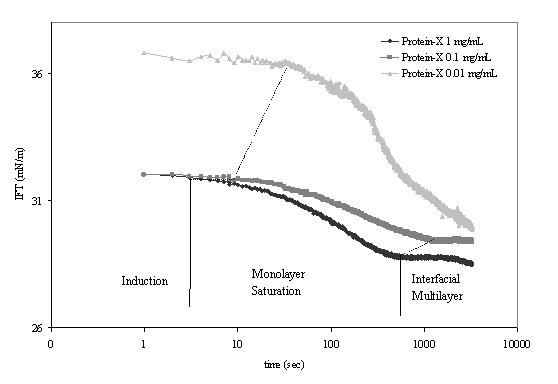187g Dynamic Interfacial Tension of Protein-X at Aqueous Solution/silicone Oil Interface
Prefilled glass syringes (PFS) have become the major delivery device for recombinant human protein therapeutics in parenteral formulation. Over 70% of protein therapeutics on the market are now delivered with PFS or, auto-injector (1). These glass syringes are coated with silicone oil for lubrication to enable the smooth movement of the plunger during injection. The protein therapeutic is directly in contact with silicone oil coated on the glass syringe barrel. It has been reported that silicone oil can increase turbidity and cause particulates in protein solution (2). However, the interactions of silicone oil with proteins in aqueous solution were not well understood.
We examined the dynamic interfacial tension (IFT) of protein-X at aqueous solution/silicone oil interface and at the aqueous solution/air interface using the pendant drop technique on a Kruss DSA 100 Tensiometer (Palo Alto, CA). The results demonstrate a significant difference between the induction period for protein-X between the aqueous/air and aqueous/silicone oil interfaces, which may indicate that hydrophobic residues on protein X have a greater affinity for the silicone oil than the air and are more strongly adsorbed on the silicone oil. This may explain why protein-X exhibits visible particulates when in contact with silicone oil from coated PFS. Moreover, at low protein concentration (10 µg/mL), Protein-X exhibits a typical dynamic interfacial tension curve of proteins in aqueous solution/oil interface (see Figure 1). The dynamic IFT curve showed three distinct time regimes, which explain the protein adsorption kinetics at the oil/water interface (3). The first was an induction regime where the IFT stayed constant, this regime is believed to be related to the protein adsorption on the silicone oil interface through diffusion. The second regime consisted of a steep decline in the IFT that is attributed to the saturation of adsorbed protein at the water/silicone oil interface. Finally protein-X reached the third regime, where IFT stayed constant due to interfacial multilayer adsorption.
Protein-X did not reach the third regime at low concentration of 10 µg/mL as it would be expected, which could be attributed either to the insufficient proteins to form an adsorbed monolayer at the water/silicone oil interface or insufficient time to reach the saturation phase. With increased protein concentration, the third regime of the IFT was observed in a shorter time. Further increased protein concentrations shortened the induction time and the reduction of the decline slope. These results will help to understand the mechanism of protein/silicone oil interaction and have implications in the particulate formation of protein at the water/silicone oil interface as well as the generation of visible particulates in prefilled syringes coated with silicone oil.

Figure 1. Dynamic interfacial tensions different concentrations of protein-X at aqueous/silicone oil interface.
References:
1. Karras L, Wright L, Cox L, Kouns T, and Akers MJ. 2000. Current issues in manufacturing and control of sterile prefilled syringes. Pharmaceutical Technology 24: 188-193.
2. Latoya SJ. Kaufmann A. Middaugh CR. 2005. Silicone oil induced aggregation of proteins. J Pharmaceutical Sci 94: 918-927.
3. C. J. Beverung, C. J. Radke, H. W. Blanch. Protein Adsorption at the oil water interface: characterization of adsorption kinetics by dynamic interfacial tension measurements. 1999. Biophysical Chemistry 81: 59-80.